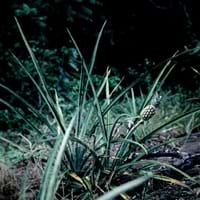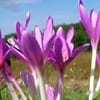Life Span
Perennial
Biennial
Type
Bulb or Corm or Tuber
Tender Perennial
Origin
Mediterranean, Turkey
South America, Brazil
Types
Not available
Not Available
Habitat
Lawn, meadows, Sunny Edge, Woodland Garden
Tropical regions
USDA Hardiness Zone
6-9
10-15
Sunset Zone
21,22
H1, H2, 24
Habit
Clump-Forming
Rosette/Stemless
Flower Color
Fuchsia, Rose
Purple, Blue Violet
Flower Color Modifier
Bicolor
Not Available
Fruit Color
Not Available
Gold, Magenta, Rose
Leaf Color in Spring
Green
Green, Gray Green
Leaf Color in Summer
Light Green
Green, Gray Green
Leaf Color in Fall
Several shades of Green
Green, Gray Green
Leaf Color in Winter
Light Green
Gray Green
Leaf Shape
Long Broad
Arrowhead
Plant Season
Spring, Fall
Spring, Summer, Fall, Winter
Sunlight
Full Sun, Partial Sun
Full Sun, Partial Sun
Growth Rate
Medium
Medium
Type of Soil
Loam
Loam, Sand
The pH of Soil
Acidic, Neutral
Acidic, Neutral
Soil Drainage
Well drained
Well drained
Bloom Time
Late Summer, Early Fall
Spring, Late Spring
Tolerances
Drought
Drought
Where to Plant?
Container, Ground, Pot
Container, Ground, Pot
How to Plant?
Corms or bulbs, Seedlings
Divison
Plant Maintenance
Low
Medium
Watering Requirements
Do Not over Water, Keep the ground moist but not water-logged
Average Water Needs, Needs less watering, Requires consistently moist soil, Water occasionally
In Summer
Lots of watering
Lots of watering
In Spring
Moderate
Moderate
In Winter
Average Water
Average Water
Soil pH
Acidic, Neutral
Acidic, Neutral
Soil Type
Loam
Loam, Sand
Soil Drainage Capacity
Well drained
Well drained
Sun Exposure
Full Sun, Partial Sun
Full Sun, Partial Sun
Pruning
Cut or pinch the stems, Remove damaged leaves, Remove dead flowers, Remove dead leaves
Remove damaged leaves, Remove dead branches, Remove dead leaves
Fertilizers
All-Purpose Liquid Fertilizer, fertilize in summer
All-Purpose Liquid Fertilizer
Pests and Diseases
Slugs
Scale
Plant Tolerance
Drought
Drought
Flowers
Showy
Insignificant
Flower Petal Number
Single
Single
Foliage Texture
Coarse
Coarse
Foliage Sheen
Not Available
Matte
Attracts
Bees, Butterflies
Beetles, Mealybugs, Mites
Allergy
poisonous if ingested, Toxic if not prepared properly
Dermititis, Itchiness
Aesthetic Uses
Beautification, Cottage Garden, Showy Purposes
Showy Purposes
Beauty Benefits
Removes pimples
Acne, For treating wrinkles, Good for skin, Improve skin tone, Skin irritation, Skin Problems, Stops hair loss
Environmental Uses
Air purification
Air purification
Medicinal Uses
Arthritis, Gout, Itching
Aging, Asthma, Atherosclerosis, Cancer, Digestion problems, Fertility, Heart problems, High blood pressure, Immunity, Indigestion, Inflammation, Itching, Skin irritation, Swelling
Part of Plant Used
Bulbs, Flowers, Seeds
Fruits
Other Uses
Used as Ornamental plant, Used for its medicinal properties
Cosmetics, Used As Food, Used as Ornamental plant, Used for its medicinal properties
Used As Indoor Plant
No
Yes
Used As Outdoor Plant
Yes
Yes
Garden Design
Alpine, Container, Mixed Border, Rock Garden / Wall
Container, Houseplant, Mixed Border, Tropical
Botanical Name
Colchicum autumnale
ANANAS nanus
Common Name
Autumn Crocus, meadow saffron, naked lady
Dwarf Pineapple, Piñita, Pink Pineapple
In Hindi
शरद ऋतु का पौधा
Pink Pineapple
In German
Herbstzeitlose
Pink Pineapple
In French
colchique d'automne
Pink Pineapple
In Spanish
cólquico
Pink Pineapple
In Greek
φθινόπωρο κρόκος
Pink Pineapple
In Portuguese
aftomn gema
Ananás-de-raposa
In Polish
aftomn żółtka
Pink Pineapple
In Latin
aftomn vitellus
Pink Pineapple
Phylum
Magnoliophyta
Not Available
Class
Liliopsida
Not Available
Family
Liliaceae
Bromeliaceae
Clade
Angiosperms, Monocots
Angiosperms, Commelinids, Monocots
Tribe
Colchiceae
Not Available
Subfamily
Not Available
Bromelioideae
Number of Species
Not Available
Properties of Autumn Crocus and Pink Pineapple
Wondering what are the properties of Autumn Crocus and Pink Pineapple? We provide you with everything About Autumn Crocus and Pink Pineapple. Autumn Crocus doesn't have thorns and Pink Pineapple doesn't have thorns. Also Autumn Crocus does not have fragrant flowers. Autumn Crocus has allergic reactions like poisonous if ingested and Toxic if not prepared properly and Pink Pineapple has allergic reactions like poisonous if ingested and Toxic if not prepared properly. Compare all the properties and characteristics of these two plants. Find out which of these plant can be used as indoor plant. If you are interested to decorate your house and garden, find out aesthetic uses, compare them and select the plant which will beautify your surrounding. Along with beautification, try comparing medicinal and edible uses of Autumn Crocus and Pink Pineapple and you can choose the plant having best and most benefits.
Season and Care of Autumn Crocus and Pink Pineapple
Season and care of Autumn Crocus and Pink Pineapple is important to know. While considering everything about Autumn Crocus and Pink Pineapple Care, growing season is an essential factor. Autumn Crocus season is Spring and Fall and Pink Pineapple season is Spring and Fall. The type of soil for Autumn Crocus is Loam and for Pink Pineapple is Loam, Sand while the PH of soil for Autumn Crocus is Acidic, Neutral and for Pink Pineapple is Acidic, Neutral.
Autumn Crocus and Pink Pineapple Physical Information
Autumn Crocus and Pink Pineapple physical information is very important for comparison. Autumn Crocus height is 7.60 cm and width 7.60 cm whereas Pink Pineapple height is 45.70 cm and width 50.80 cm. The color specification of Autumn Crocus and Pink Pineapple are as follows:
Autumn Crocus flower color: Fuchsia and Rose
Autumn Crocus leaf color: Green
Pink Pineapple flower color: Purple and Blue Violet
- Pink Pineapple leaf color: Green and Gray Green
Care of Autumn Crocus and Pink Pineapple
Care of Autumn Crocus and Pink Pineapple include pruning, fertilizers, watering etc. Autumn Crocus pruning is done Cut or pinch the stems, Remove damaged leaves, Remove dead flowers and Remove dead leaves and Pink Pineapple pruning is done Remove damaged leaves, Remove dead branches and Remove dead leaves. In summer Autumn Crocus needs Lots of watering and in winter, it needs Average Water. Whereas, in summer Pink Pineapple needs Lots of watering and in winter, it needs Average Water.





